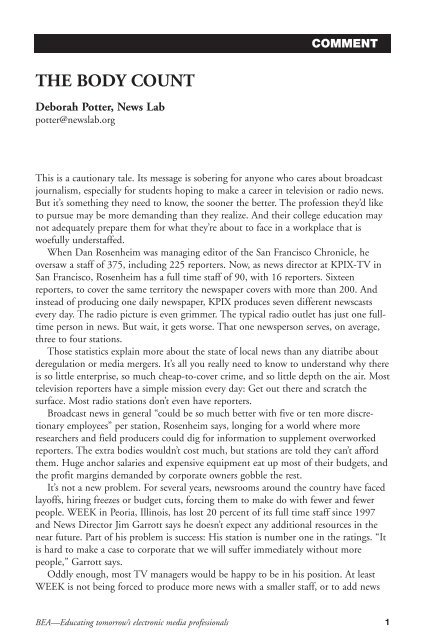Feedback November 2002 (Vol 43 No 4)
Feedback November 2002 (Vol. 43, No. 4) - Broadcast Education ...
Feedback November 2002 (Vol. 43, No. 4) - Broadcast Education ...
Create successful ePaper yourself
Turn your PDF publications into a flip-book with our unique Google optimized e-Paper software.
COMMENTTHE BODY COUNTDeborah Potter, News Labpotter@newslab.orgThis is a cautionary tale. Its message is sobering for anyone who cares about broadcastjournalism, especially for students hoping to make a career in television or radio news.But it’s something they need to know, the sooner the better. The profession they’d liketo pursue may be more demanding than they realize. And their college education maynot adequately prepare them for what they’re about to face in a workplace that iswoefully understaffed.When Dan Rosenheim was managing editor of the San Francisco Chronicle, heoversaw a staff of 375, including 225 reporters. <strong>No</strong>w, as news director at KPIX-TV inSan Francisco, Rosenheim has a full time staff of 90, with 16 reporters. Sixteenreporters, to cover the same territory the newspaper covers with more than 200. Andinstead of producing one daily newspaper, KPIX produces seven different newscastsevery day. The radio picture is even grimmer. The typical radio outlet has just one fulltimeperson in news. But wait, it gets worse. That one newsperson serves, on average,three to four stations.Those statistics explain more about the state of local news than any diatribe aboutderegulation or media mergers. It’s all you really need to know to understand why thereis so little enterprise, so much cheap-to-cover crime, and so little depth on the air. Mosttelevision reporters have a simple mission every day: Get out there and scratch thesurface. Most radio stations don’t even have reporters.Broadcast news in general “could be so much better with five or ten more discretionaryemployees” per station, Rosenheim says, longing for a world where moreresearchers and field producers could dig for information to supplement overworkedreporters. The extra bodies wouldn’t cost much, but stations are told they can’t affordthem. Huge anchor salaries and expensive equipment eat up most of their budgets, andthe profit margins demanded by corporate owners gobble the rest.It’s not a new problem. For several years, newsrooms around the country have facedlayoffs, hiring freezes or budget cuts, forcing them to make do with fewer and fewerpeople. WEEK in Peoria, Illinois, has lost 20 percent of its full time staff since 1997and News Director Jim Garrott says he doesn’t expect any additional resources in thenear future. Part of his problem is success: His station is number one in the ratings. “Itis hard to make a case to corporate that we will suffer immediately without morepeople,” Garrott says.Oddly enough, most TV managers would be happy to be in his position. At leastWEEK is not being forced to produce more news with a smaller staff, or to add newsBEA—Educating tomorrow’s electronic media professionals 1
















